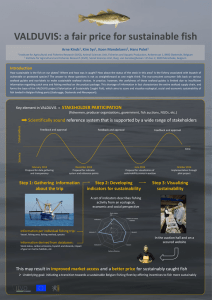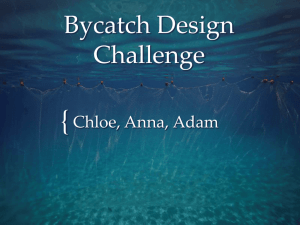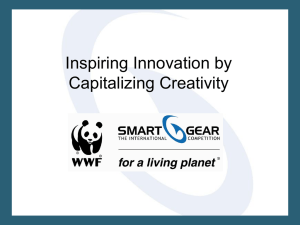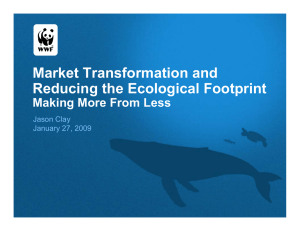Bycatch Can you pick the target catch? Fact sheet:
advertisement
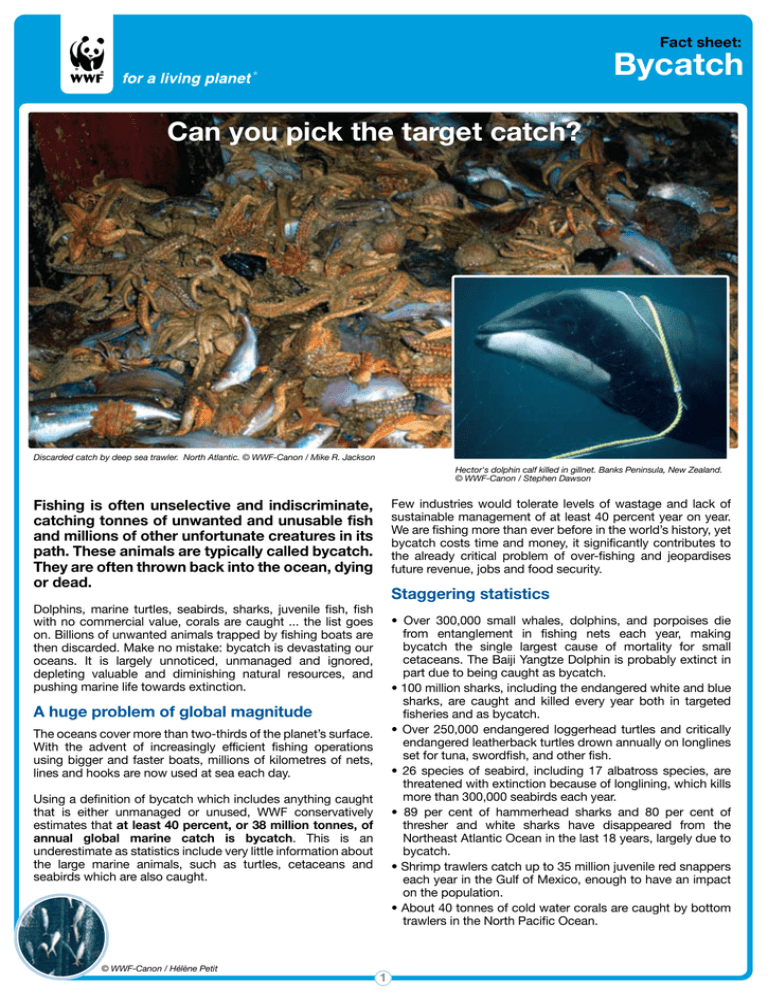
Fact sheet: Bycatch Can you pick the target catch? Discarded catch by deep sea trawler. North Atlantic. © WWF-Canon / Mike R. Jackson Hector's dolphin calf killed in gillnet. Banks Peninsula, New Zealand. © WWF-Canon / Stephen Dawson Fishing is often unselective and indiscriminate, catching tonnes of unwanted and unusable fish and millions of other unfortunate creatures in its path. These animals are typically called bycatch. They are often thrown back into the ocean, dying or dead. Few industries would tolerate levels of wastage and lack of sustainable management of at least 40 percent year on year. We are fishing more than ever before in the world’s history, yet bycatch costs time and money, it significantly contributes to the already critical problem of over-fishing and jeopardises future revenue, jobs and food security. Staggering statistics Dolphins, marine turtles, seabirds, sharks, juvenile fish, fish with no commercial value, corals are caught ... the list goes on. Billions of unwanted animals trapped by fishing boats are then discarded. Make no mistake: bycatch is devastating our oceans. It is largely unnoticed, unmanaged and ignored, depleting valuable and diminishing natural resources, and pushing marine life towards extinction. • Over 300,000 small whales, dolphins, and porpoises die from entanglement in fishing nets each year, making bycatch the single largest cause of mortality for small cetaceans. The Baiji Yangtze Dolphin is probably extinct in part due to being caught as bycatch. • 100 million sharks, including the endangered white and blue sharks, are caught and killed every year both in targeted fisheries and as bycatch. • Over 250,000 endangered loggerhead turtles and critically endangered leatherback turtles drown annually on longlines set for tuna, swordfish, and other fish. • 26 species of seabird, including 17 albatross species, are threatened with extinction because of longlining, which kills more than 300,000 seabirds each year. • 89 per cent of hammerhead sharks and 80 per cent of thresher and white sharks have disappeared from the Northeast Atlantic Ocean in the last 18 years, largely due to bycatch. • Shrimp trawlers catch up to 35 million juvenile red snappers each year in the Gulf of Mexico, enough to have an impact on the population. • About 40 tonnes of cold water corals are caught by bottom trawlers in the North Pacific Ocean. A huge problem of global magnitude The oceans cover more than two-thirds of the planet’s surface. With the advent of increasingly efficient fishing operations using bigger and faster boats, millions of kilometres of nets, lines and hooks are now used at sea each day. Using a definition of bycatch which includes anything caught that is either unmanaged or unused, WWF conservatively estimates that at least 40 percent, or 38 million tonnes, of annual global marine catch is bycatch. This is an underestimate as statistics include very little information about the large marine animals, such as turtles, cetaceans and seabirds which are also caught. © WWF-Canon / Hélène Petit 1 Although some fisheries have begun to tackle the problem, the overwhelming trend is one of inaction and inertia — from small-scale artisanal fisheries to large commercial international operations. Unless this changes, bycatch could well be the final nail in the coffin for many endangered marine species. On top of this, with so many fish, including juvenile fish, being wastefully discarded, bycatch is contributing to the global problem of overfishing and declining fish stocks, as well as endangering food security in several poor countries. industry and civil society, from individual fishers and communities to large industrial fleets, from governments to recreational anglers. WWF has created a coordinated global effort that works with academia, the fishing industry, other conservation organizations and governments to stimulate new solutions and then spread them throughout the world. 1. Integrating fisheries management with conservation WWF has identified three fisheries as catalytic for addressing bycatch in order to achieve global transformational reforms of the industry. In order to secure long term success, policy and legislation for reduced bycatch must be in in place at national and international levels. WWF is therefore working with governments and fisheries to strengthen and enact leglisation, treaties and agreements. Pacific longline fisheries: Each year in the Pacific Ocean, millions of baited hooks are set on longlines in order to catch tuna, as well as other fish like swordfish and mahi mahi. However, the hooks also catch marine turtles, sharks, billfish, seabirds, and marine mammals, as well as juvenile fish and other fish species. The problem is perhaps most acute for marine turtles, especially the critically endangered Pacific leatherback turtles. The population is predicted to become extinct in the next 5-30 years if this decline continues. In all its conservation work, WWF promotes ecosystem based management which makes ecological sustainability the primary goal of management, and takes careful account of the condition of ecosystems which may affect fish stocks and their productivity. It also means taking equally careful account of the ways fishing activities may affect marine ecosystems. Tropical shrimp trawl fisheries: Trawl nets which are used to catch the vast majority of tropical shrimp entrap up to 5-20kgs of bycatch for each kilogram of shrimp. Species caught include marine turtles, juvenile fish, cetaceans, dugongs, sharks, seahorses, seabirds, sea snakes, and corals and other invertebrates such as crabs and starfish. 2. Policy work There are at least 130 bycatch agreements, regulations, and legislation for reducing bycatch around the world, with approximately 40 having international scope. These include regulations on net mesh sizes, fishing areas, rules for discarding fish, requirements for bycatch mitigation measures, recovery plans for specific species, and international standards and best practices for fishing operations. North Atlantic trawl fisheries: The iconic Atlantic cod was once responsible for one of the most productive fisheries in the world, generating such wealth that it played a pivotal role in the economic and social development of the northern hemisphere. Relentless overfishing has now depleted stocks to critically low levels and stock recovery is hindered because large numbers of juvenile cod are caught in trawl fisheries that target other fish such as haddock, flatfish (e.g. halibut, plaice) and Nephrops (a small lobster species). However, to have any effect these policies need to be implemented and enforced. Such policies need to be continually developed at national, regional, and international levels – by governments, regional fisheries management organizations (RFMOs), other fisheries management bodies, and various international fora with an influence on fishing, such as the UN Food and Agriculture Organization (FAO) and the World Trade Organization (WTO). So what’s the answer? • Mobilizing funding In several cases, part of the problem with regional and international efforts to reduce bycatch is that governments are not implementing existing regulations and frameworks, in large part due to a lack of funding. WWF is therefore looking at ways to mobilize funding for such implementation. Proven solutions do exist to reduce bycatch — and others are waiting to be discovered. WWF and its partners are working around the world to develop, test, and implement new fishing gear, and to integrate conservation science into effective fisheries management. WWF and its partners are also working to strengthen legislation on bycatch and to raise consumer awareness about sustainably caught fish. • Influencing International Agreements WWF is a member of the OECD Ministerial Task Force on Illegal, Unregulated, and Unreported (IUU) Fishing, which, by tackling the huge problem of IUU fishing, will also help reduce bycatch. WWF also worked successfully for the International Whaling Commission (IWC) to start tackling cetacean bycatch and regularly intervenes and positively engages with the FAO’s Committee on Fisheries (COFI). The aim is to encourage sustainability in the world’s fisheries. This means that fishers, consumers, the seafood industry, and governments must provide practical solutions to counteract the enormous environmental harm that bycatch is causing. Evidence suggests that many, but not all, species can rebound relatively quickly if given the chance. • Carrying out research WWF and its partners perform cutting-edge research on fisheries and bycatch to help governments and the fishing industry keep abreast of new trends and to react accordingly. WWF’s analysis estimating the global scale of bycatch at around 40% is one such example. Examples of WWF’s work on bycatch WWF has more than 70 bycatch projects in over 40 countries which work with all stakeholders in the fishing 2 • Certifying sustainable fisheries and seafood products In 1997, WWF and Unilever, one of the world's largest consumer food companies, formed the now independent Marine Stewardship Council (MSC), which identifies and certifies sustainable fisheries in order to provide consumers with a choice in the marketplace. The certification process includes a management framework for fisheries to reduce bycatch and other ecological impacts of fishing. More than 100 major seafood buyers have now pledged to purchase MSC-certified seafood products, including large supermarket chains in Europe and the US - two of the world’s largest markets for fish. There are now 2000 MSC certified products. where most target fish, but fewer bycatch species, are found. Escape Panels The mesh in trawl nets is often tied into a diamond shaped configuration. As more fish are caught and the weight in the trawl net increases, these diamond-shaped meshes stretch and the opening narrows, preventing the escape of juvenile/small fish. • Looking for new fisheries management models which help bring together the right to fish with the responsibility for looking after the ecosystem. Bird scaring devices • Acknowledge what is really being fished In many cases, a fishery management plan is recognising only a small portion of what constitutes the real fishery, meaning that everything else in the fishery is labelled as “bycatch” even if it is really being targeted. This leads to high levels of unregulated and uncontrolled fishing which is contributing to the overfishing crisis. Seabirds can die when they hit the ropes that attach fishing gear to the fishing vessel. They accidently strike the ropes because they are attracted to both the baited longline hooks after deployment from the vessel, and also from discharges of fish waste from on-board processing. Streamer (tori) lines attached near these ropes are extremely effective at preventing birds from striking these ropes. They consist of lines with brightly coloured tubing or ‘streamers’ which flap about unpredictably in the wind. They also deter birds from foraging near bait/offal discharges. 3. Smarter fishing gear Bycatch mortalities can often be reduced by modifying fishing gear so that fewer non-target species are caught or so that non-target species can escape. In many cases, these modifications are simple and inexpensive. Smart Gear competition In 2004, WWF and an unprecedented partnership of fishermen, industry leaders, and scientists launched a global competition called Smart Gear to find the most practical, innovative design for fishing gear that reduces bycatch. This competition has been running successfully ever since, generating new innovations and enthusiasm to help eliminate bycatch. www.smartgear.org Turtle excluder devices (TEDs) for shrimp trawlers TEDs are metal grids that allow shrimp to pass into the main part of the trawl net, but which allow marine turtles to escape with only a minimal reduction in shrimp catch. Turtle Excluder Devices fitted to shrimp trawl nets can reduce turtle mortality by up to 90% and in some cases, can also improve the quality of the shrimp catch. 4. Zoning Circle hooks for longlines Limiting fishing in important habitats or at certain times can help prevent bycatch. Such management zoning can include: In many fisheries, the use of certain types of circle hooks instead of traditional J-shaped hooks on longlines can significantly reduce marine turtle deaths without adversely affecting commercial catch rates. • Short term, seasonal or permanent time, area, or gear restrictions/requirements Deeper setting of longlines • Short term, seasonal or permanent no-take zones Bycatch of marine turtles, sharks, and non-target fish in tuna and swordfish longline fisheries can be reduced through a simple modification that allows the baited hooks on longlines to fish at depths below 100m – the depth • Marine Protected Areas (MPAs) Background image: Circle hook. United States. © WWF-US / Jill Hatzai North Atlantic Gannet drowned in fishing net. Nordmore, Norway. © WWF-Canon / Nils Aukan Young shark in gillnet. Mafia Island, Tanzania. © WWF-Canon / Jason Rubens 3 5. Success stories protect the critically endangered Maui's dolphin – the world’s smallest and rarest marine dolphin, whose numbers have been severely depleted by set gill net fishing. Fishing smarter: • The Inter American Tropical Tuna Commission IATCC has taken the lead together with WWF in reducing marine turtle bycatch from the longline fleet of the eastern Pacific Ocean. Here, extensive engagement with the National Oceanographic and Atmospheric Administration NOAA, WWF and the local fishermen has helped move towards the broad adoption of large circle hooks which reduce turtle bycatch in some cases by up to 90 percent. • In the Gulf of California, another victim of bycatch, the vaquita – the smallest porpoise of the world and critically endangered species– will benefit from a giant sanctuary. • In September 2007, the Northwest Atlantic Fisheries Organization NAFO took measures to protect cold water corals by closing a sensitive area to all bottom fishing. • The Convention for the Conservation of Antarctic Marine Living Resources CCAMLR has a high level of commitment to bycatch reduction. As a result of their conservation measures, seabird bycatch has been dramatically reduced through the adoption of streamer lines, setting longlines at night (when seabird activity is low), discharging fish offal when the gear is not being set, and ensuring the nets are clean (to minimize seabird foraging). • In October 2008, Norway and the European Union jointly agreed to an immediate ban on high grading (discarding less valuable fish to make room for more valuable fish) in North Sea fisheries. They also included the use of selective fishing gear, like the “Eliminator Trawl” – winner of the 2007 Smart Gear Competition – to stop the catch of juvenile cod bycatch and the use of permanent, seasonal, or real time closures, to stop the catch of adult spawning cod or juvenile cod. Managing better: • In summer 2007, the Moroccan government recently banned gillnetting in its waters. Under the new law, Morocco will destroy all its driftnets - thereby ensuring that the banned gear is not simply sold on to other countries. • The survival chances of the albatross, now officially the most threatened seabird family in the world, have been improved following a report recently released by WWF-South Africa. The findings will identify management measures to reduce the wasteful killing of these birds while not unnecessarily disrupting fishing activities or impacting other vulnerable marine life like turtles and sharks. • In February 2009, the North Pacific Fishery Management Council has decided that commercial fishing in US Arctic waters is to be banned, at least until its effects are understood. This is the most powerful application yet of the precautionary principle to fisheries. • In 2008, the New Zealand government banned gill nets in inshore waters on New Zealand's North Island to Bycatch of Leatherback turtle, Atlantic ocean. © WWF-Canon / Héléne Petit Find out more... This fact sheet has been designed to give a broad overview of the environmental harm that bycatch can cause, and to give examples of WWF's work and solutions on the ground. For more detailed information on bycatch, species, oceans, fisheries, WWF, and the work we do, please visit www.panda.org/bycatch Take action... Visit www.passport.panda.org to find out how you can take action to help protect species and fragile environments. WWF International Avenue du Mont-Blanc CH-1196 Gland Switzerland 4 .org/bycatch tel: +41-22 364 9111 fax: +41-22 364 0640

